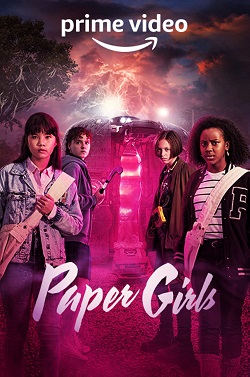This is mark Joseph “young” blog entry #474, on the subject of Preliminary Temporal Thoughts on Paper Girls.
Reader Scott Curtis contacted me to ask,
I am a longtime reader of your articles on time travel cinema. My wife and I are watching the short lived show Paper Girls on Amazon Prime, and I was wondering if you have taken a look at it? If so I was wondering if you have considered turning your analytical eye on it.
Quite a few years back I wrote an explanation of Why Not Analyze Time Travel Television Shows? much of which still applies. Granted, it appears from the Amazon description that Paper Girls is only 8 episodes, but that’s quite a bit of material, and in my current circumstances getting the opportunity to watch a two-hour movie is challenging.
However, I did take a look at the blurb, and ran into an obvious problem. It tells us that they have to interact with their adult selves. Let’s consider this.
If they left from 1988 and arrived in 2019, they ceased to exist in time in 1988 and don’t exist in 2019. Before they can interact with their future selves, they have to return to the past and create future selves. That means they need an N-jump resolution which they’re not going to get, because the second problem is once they’ve returned to the past and so replaced themselves in history, the world changes drastically around them–let’s face it, four fifteen-year-old girls who live to be forty-six is going to mean some of them marry and/or have children, and we hit the genetic problem in spades. Further, the selves they meet in the future are going to be the ones who made the trip they are currently making but didn’t find themselves in the future. This then sets up the problem that they have to return to the past–we need a stable sawtooth snap–and we have to repeat history with versions of themselves who did make that trip, who then are different from having met their older selves when they were younger. Getting this to stabilize is very complicated.
Further, telling stories in this temporal morass means choosing which timeline, and the only one that will exist beyond their return to the past is the last one. However, the blurb also says that they have to deal with warring time traveling factions. Assuming these come from the yet further future, they cannot come into existence until our first anomaly is resolved–our girls have met their younger selves and remember having met their older selves–because only after that can there be a tomorrow. Then time has to advance to a moment in the future when one of those factions travels into that history between 1988 and 2019, which again changes that history and forces a repeat of their anomaly, which happens again when the other faction arrives attempting to alter history again, and every time one of those future factions travels to any point in the past, even points after 2019, they create ripples in history reaching all the way back to 1988 (because if in 2050 faction A sends someone to 2030 who impacts persons in faction B, when faction B sends someone from 2040 to 2019 that person will be different, impacted by the 2030 visit, and so will impact our four girls differently, changing events flowing from 1988).
I see very little hope for a satisfactory temporal resolution to such a morass, and expect that it’s going to crash into an infinity loop at some point, the end, no future.
If it is not obvious, though, I need to caveat that I have not watched the show; this is entirely based on the descriptive blurb.
Much of this is covered better in the book The Essential Guide to Time Travel, available in paperback and Kindle formats.
Scott adds that the handling of time travel is unlike anything he has seen elsewhere, so I might try to catch a few episodes and that might inspire some additional thoughts on it.
I hope this helps.
